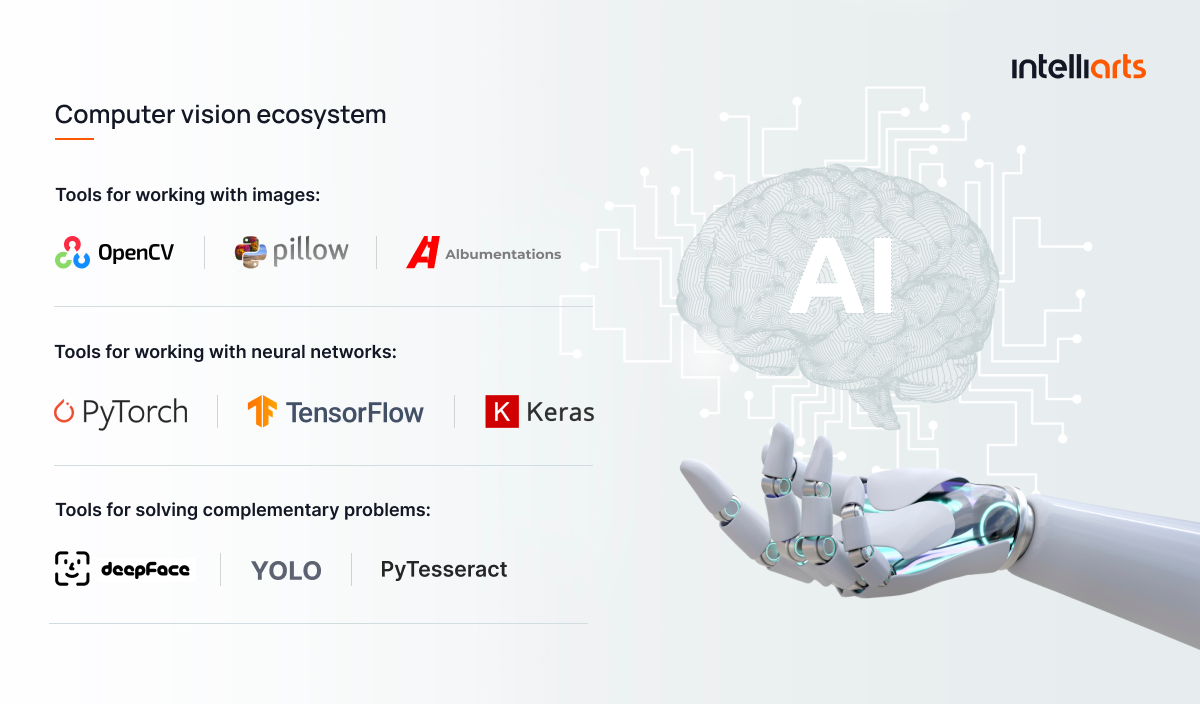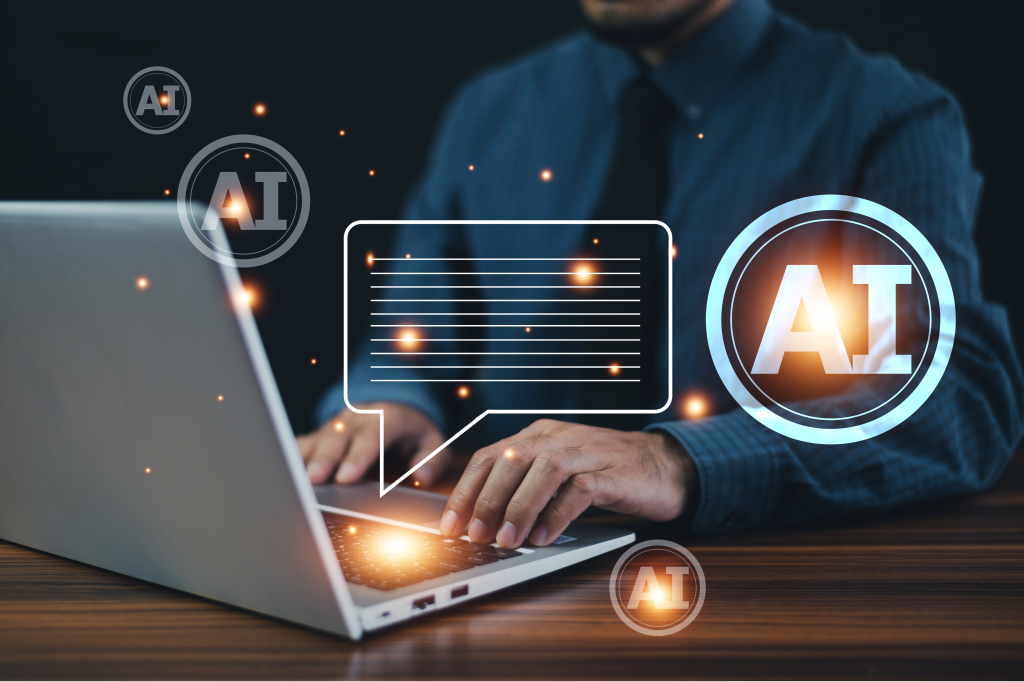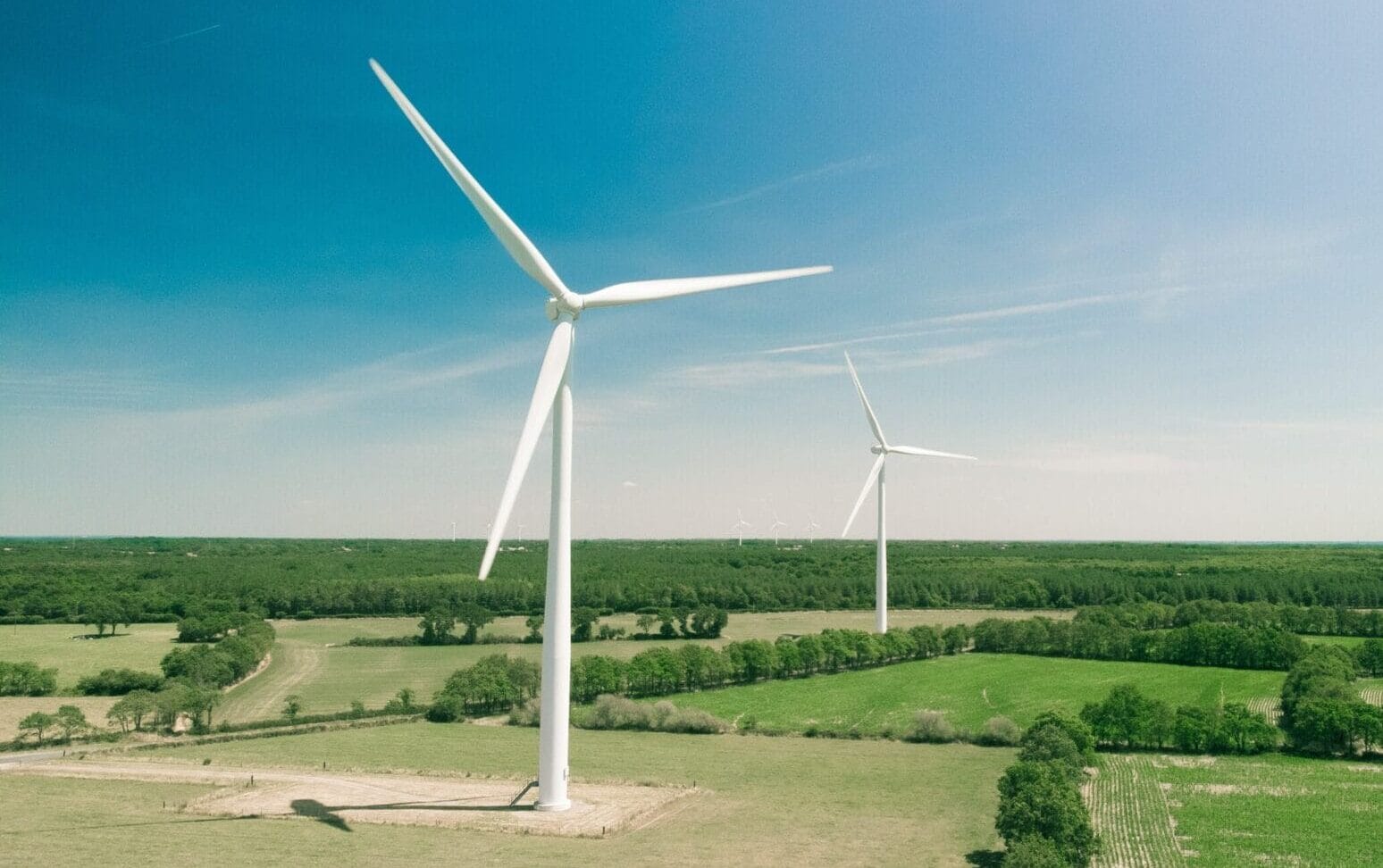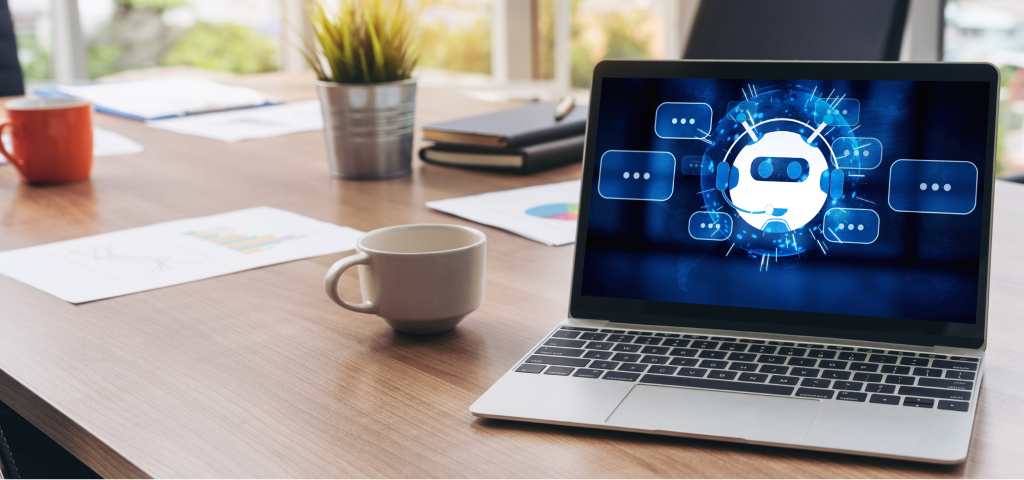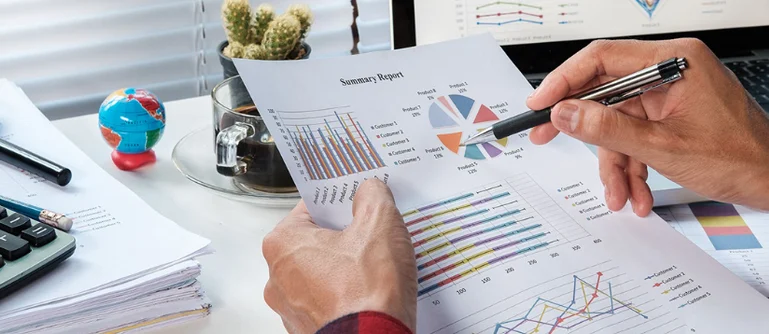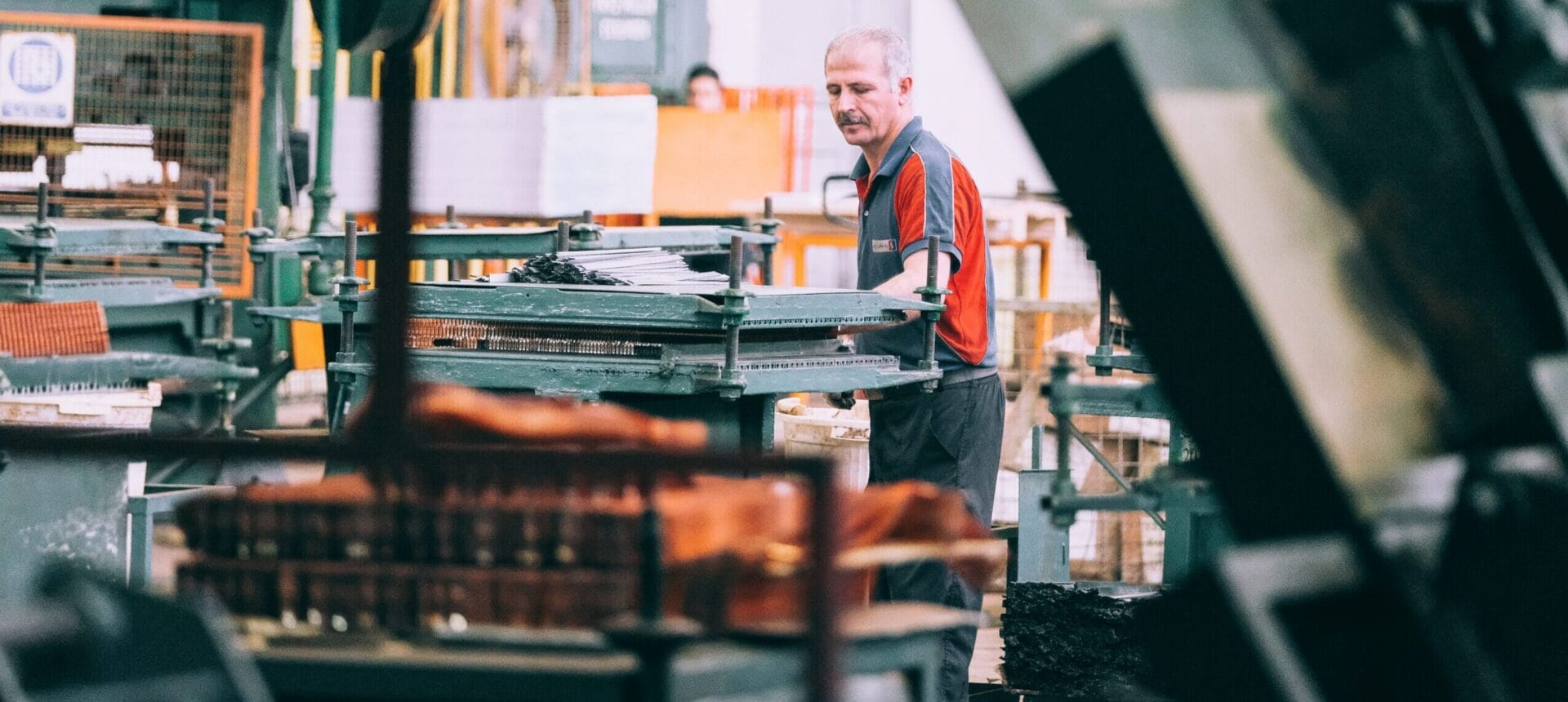In modern-day reality, it’s possible to build a computer vision-based AI infrastructure using available software solutions. Computer vision use cases in manufacturing and other fields range from counting objects in batches of images to deriving meaningful information from them.
A large newswire distribution network — GlobeNewswire, reveals that the global computer vision market reached $11.7 billion in 2021. It’s projected to grow at a CAGR of 6.9% throughout the next seven years to as much as $21.3 billion in 2023. The tendency is quite solid. It shows the increase in the volume of computer vision-powered products and services across industries.
It’s worth noting that computer vision technology is related to the field of machine learning (ML), which is also useful to be versed in. Now, let’s deepen into computer vision applications in insurance, manufacturing, or any other industry, find out what business challenges the technology solves, and discover from which components an AI system can be formed.
Major tasks computer vision solves nowadays in manufacturing and other industries
To answer the question “what is computer vision,” we might need a close look at the modern-day capabilities of this technology. Here is the list of tasks that are solved within this field of artificial intelligence.
-
Image classification. For this, the computer vision algorithm classifies images or their parts into a set of predefined classes. The process is based on a set of sample images that have already been classified correctly. Image classification is extremely helpful for quick and fully automated labeling batches of images.
-
Object recognition, detection, and tracking. It’s a more complex process that is often applied to videos. Identifying an object in the image or a frame is known as object recognition. At the same time, object detection is a process of finding a specific position of an object in a single frame. Finally, object tracking is identifying a specific position of a target object and tracking its movement in every consecutive frame in a video. Object recognition, detection, and tracking algorithms are often used in combination, for one, when there is a need to process videos and track the movement of specific objects in real time.
-
Image segmentation. This technique is applied to split digital data into subgroups or segments, which reduces the overall complexity of the image being analyzed. Images segmentation algorithms that are used for this purpose can locate and label objects as well as indicate their precise boundaries. It’s done based on the characteristics of the pixels in images.
-
Face and person recognition. To implement this task, AI-powered computer vision technology detects the facial features of people in images. Then, it compares those attributes against ones previously collected and presently hosted in various databases to find a match. In case the system doesn’t find a match, a person’s data might be used for further analysis. Face detection and recognition algorithms can identify a person quite accurately, which finds multiple security-related usages.
-
Image restoration. AI-powered computer vision systems can also recover images from their degraded versions. Deblurring, colorizing, removing scratches, depixelizing, and filling blank spaces in images are some of the image restoration algorithms’ capabilities. Getting rid of corruption in large batches of images is a weighty contribution to numerous creation activities.
-
Image generation. Text-to-image generation is another AI-powered capability. A computer vision system simply takes text descriptions as input and, using two neural networks, one for image generation and one for image judgment, forms an output image. The result is usually close to real-life examples of what has been requested. Image generation algorithms are widely used to create digital visuals in just a few clicks.
-
Pose estimation. This task is focused on detecting the position and orientation of objects, which are, most often, human figures. Human Pose Estimation (HPE) is done by predicting the possible location of key points, i.e., head, elbows, head, knees, etc. The result of HPE is a 2D or 3D representation of a human model. Pose estimation is a demanded technique in animation, augmented reality, surveillance, and other activities.
Depending on the particular business needs, AI and computer vision may have a lot to offer. It’s especially useful for processing large batches of digital materials with minimal labor involvement needed. The potential of computer vision technology to optimize expenses and streamline creative operations definitely shouldn’t be overlooked.
Solving a computer vision task with the right tech stack
When working with digital image processing, the workflow is often complex and multi-layered. But the good thing about existing and often open-source computer vision tools is that there is no pressing need to code a new one from scratch. So, by exploiting those ready-made tools and platforms, ML engineers can focus their efforts and energy on solving business tasks and achieving better project outcomes rather than overcoming development challenges.
The variety of image processing solutions present on the market can already be integrated into the artificial intelligence solution at minimal development time and at low investment costs. Even better if engineers already have substantial experience using the tech stack needed to work with a specific computer vision solution, as it may make the use of IT resources even more efficient.
Let’s review a set of real-life tools and frameworks that an ML engineer may use to build an AI solution and solve computer vision tasks:
Tools for working with images
Such software solutions are used to perform processing tasks, like the ones mentioned previously, over digital images.
-
OpenCV
OpenCV is an open-source computer vision library optimized for real-time image processing tasks. It offers a simple IT infrastructure for artificial intelligence applications and access to over 2,500 computer vision algorithms of varying complexity. OpenCV has interfaces for multiple programming languages, support for desktop and mobile platforms, and an active community of contributors.
-
Pillow
Python Imaging Library (PIL) is an extensive library that contains fairly powerful image processing functionality. Besides image processing and image displaying, the Pillow module can pull statistical data out of images for further usage.
-
Albumentations
Albumentations is a Python-based library for image augmentation. Expanding image data sets through pixel-level augmentation with this tool is of high value for deep learning and computer vision tasks as it increases the quality of trained models.
Should you require assistance with building a computer vision workflow, don’t hesitate to reach out to our team of well-seasoned AI and ML engineers.
Tools for working with neural networks
Neural networks (NN) are computing systems the interconnected nodes of which are patterned after the operation of neurons in the human brain. NN is one of the most commonly used approaches to computer vision, and it’s focused on recognizing relationships between pieces of unstructured data.
-
PyTorch
PyTorch is an open-source machine learning framework. It is extensively used for computer vision and natural language processing tasks. PyTorch might also be used for building deep learning models. PyTorch presents a rich ecosystem of tools and libraries, such as Torchvision computer vision library, and supports cloud platforms.
-
TensorFlow
TensorFlow is an end-to-end machine-learning platform. The main usages of this example of computer vision-enabled platform are to conduct numerical computation and handle all aspects of machine learning systems, such as training and inference.
-
Keras
Keras is the Python application programming interface (API). Its primary usage is for implementing neural networks, creating deep models, and providing distributed training of deep learning models.
These days, automated claims processing with machine learning is increasingly becoming common in the insurance industry. It’s a great use case to consider when thinking about the potential use case of ML technology for the business.
Tools for solving complementary tasks
There is also an array of tools that serve for additional image processing tasks and are often used together with the ones listed above:
-
PyTeseract
PyTesseract is a Python-based Optical Character Recognition (OCR) tool. It’s capable of reading text in images and files that have been previously converted into an image format. PyTesseract can recognize handwritten words, but it works best with computer-generated text pieces.
-
YOLO
YOLO is a neural network algorithm that provides real-time object detection and image segmentation capabilities. The best thing about YOLO is the speed at which it can process images. The top rate available reaches slightly more than 150 frames per second (FPS). It means that YOLO can even process streaming video with less than 25 milliseconds of latency.
-
DeepFace
DeepFace is a Python-based face recognition and facial attribute analysis library. Its capability to identify human faces in digital images can be used for solving face verification, real-time face analysis, description of face properties, and other tasks.
The listed and other available tools are often versatile, meaning that they are capable of performing multiple tasks. So, a combination of a few of them may already provide a common IT infrastructure and serve as a core of a basic computer vision solution.
Popular AI-powered computer vision applications across the industries
The number of computer vision use cases is truly vast. Potentially, there will be no niche in which AI-powered computer vision technology wouldn’t find implementation. But for now, let’s review five large fields of activity in which AI already plays a considerable role.
Insurance
Modern-day provision of insurance services is heavily digitalized and data-dependant. No wonder the usage of computer vision in insurance is becoming increasingly popular. It’s manifested in such ways as:
-
Vehicle damage assessment. When a car accident takes place, and a liable party applies for insurance, the vehicle necessarily undergoes the damage assessment procedure. Its purpose is to evaluate the repair work and the amount of reimbursement. Performing this manually is rather time inefficient. Simultaneously, computer vision only needs high-quality pictures of the vehicle and a few seconds to analyze the precise magnitude of damage.
-
Fraud detection. Insurance claim fraud is a major business risk in the industry. To stay profitable and preserve a good brand image, companies have to balance between investigating cases for a prolonged time and having a high rate of incorrect payouts. Here, AI-powered computer vision can assist in identifying fake images forged to support a knowingly false claim or validating that the image of, for example, damaged property is in line with the claim.
-
Roof condition assessment. Validating the roof’s age, condition, and other characteristics, as well as its vulnerability to hail and wind damage, has always been challenging for inspectors. Computer vision can check and monitor the roof condition of thousands of buildings. Such a property risk assessment relies upon high-resolution views and aerial imagery.
Computer vision technology is totally able to accelerate and enhance processes throughout the entire insurance lifecycle. So, there are all good reasons to use it extensively.
You may also find it useful to learn more about applications of Machine Learning in the insurance sector.
Computer Vision Use Cases in Manufacturing
Manufacturing is one of the most technology and labor-intensive sectors. Within it, computer vision is commonly used for the following purposes:
-
Optical quality inspection. AI-powered inspection systems may be present in R&D laboratories, warehouses, and, most often, in production lines. They help to achieve Quality Assurance compliance by providing automated optical testing of product quality, cleanliness of production and warehouse areas, the integrity of packaging, and more.
-
Factory synchronization. Using computer vision-powered cameras throughout the facility to track material and product movement is another interesting implementation of the technology. When this data is synced back to manufacturing systems, it can be used to schedule and allocate resources dynamically. It both prevents shortages and optimizes inventory expenses. Getting started with a smart factory is possible with AI-driven technologies.
-
Product assembly. The usage of automated and, most often, microelectronic assembly is highly prevalent these days. Robotic production lines, powered by computer vision technology, combine the intelligence and optical abilities of a human with the efficiency, consistency, and productivity of a computer. They are extremely effective in joining modules of complex machinery.
Higher productivity, quality, and efficiency are what computer vision in AI brings to manufacturing businesses.
Read also: Digital Twin: A New Tool in Manufacturers’ Arsenal
Agriculture
Agriculture businesses often have large amounts of property that are challenging to maintain. To optimize expenses while preserving the high quality of products, companies exploit computer vision capabilities in the following ways:
-
Livestock Farming. As such production intensifies, it becomes difficult to provide care to thousands of animals per management unit. It’s especially true considering the gradually rising farm labor shortage. Through cameras, computer vision systems can provide real-time, round-the-clock monitoring of animals. Automatic and non-invasive analysis of animal behavior patterns, their feedings, etc., is often enough to have sufficient control over farms.
-
Poultry Farming. In the case of domesticated species, AI-powered systems may be used for farm management automation, disease detection, egg examination, animal welfare analysis, and more. Having accurate information about the state of farm animals directly results in better product quality and lower expenses on farm maintenance.
-
Yield Estimation. This common preharvest practice supports informed decision-making. AI-driven automatic counting of fruits and vegetables enables an accurate yield prediction. Since allocating essential logistics, such as supplies or transportation means, fully depends on the yield, it means that having better prediction ensures better resource distribution.
Surprising enough, agriculture has always been a tech-saturated sector of economics. Such computer vision applications as those listed above are a nearly common practice globally.
Building, operating, and maintaining computer vision solutions requires AI and ML expertise. In case having your in-house engineering team doesn’t seem to align with your business strategy, consider an outsourcing model. Intelliarts team acts as a technology AI consultant and a partner for businesses from various domains. If you’re unsure how to implement your business idea for AI and computer vision usage, don’t hesitate to reach out to us for a strategy session.
Logistics
From a certain perspective, logistics is all about the allocation and distribution of resources available. Here are the ways in which AI-powered computer vision technology may assist in this niche:
-
Traceability and tracking of goods. Localization of logistics objects is often achieved by attaching optical identifiers, such as barcode labels or QR codes. Image processing algorithms can capture and read these optical codes as well as recognize container numbers automatically. This largely simplifies the tracking of goods being transported.
-
Occupancy of storage and traffic areas. Knowing a load of docs or parking lots can streamline logistics notably. When AI-driven cameras placed in such areas detect and report their occupancy, this data is used by drivers and dispatchers to optimize the route.
-
Goods and pallet positioning. Palletized goods are often moved manually with the help of palette handlers. While palletizing robots do exist, both humans and machines make mistakes. That’s why it’s useful to automate the acquisition of dimensioning measurement data. With one single image frame, scanner-based systems that are driven by AI can indicate and report errors in proper goods and pallet positioning. For overloaded warehouses, this may be a life-saving feature.
If utilized effectively, computer vision in logistics can minimize loss of goods cases, enhance processes of transporting and storing product items, automate maintenance processes, and solve maintenance problems with machine learning techniques.
Medical Imagining
The healthcare sector is known for its high level of modern technology adoption. Here are some medical imagining techniques that can benefit from computer vision usage.
-
X-rays. An output of such an examination is 2D pictures of internal body structures. Trained computer vision algorithms can identify bone fractures, problems in soft tissues, etc.
-
MRIs. Radiological scanning of multiple organ systems also produces detailed images that can be processed in batches by AI algorithms. They exploit texture, shape, contour, and other factors to produce a potential diagnosis.
-
Ultrasounds. Outcomes of diagnostic medical sonography used for monitoring an unborn baby or to diagnose a condition can also be processed with AI systems. Smart algorithms assist with an accurate and measurable assessment through means of medical image classification, detection, and segmentation.
Smart image processing does not fully replace manual diagnosing. Yet, it may assist with processing large batches of testing results and validate the opinion of a doctor, minimizing the probability of human error this way.
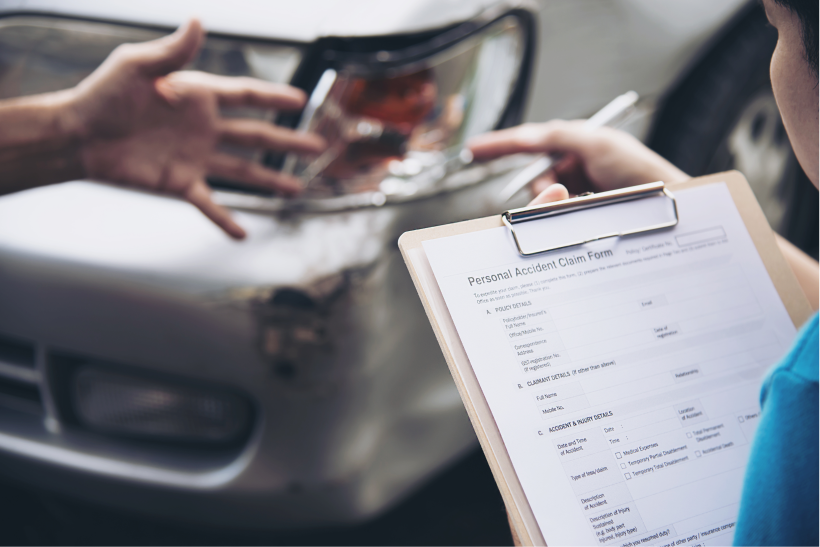
Final Take
The modern-day environment sets strict requirements for businesses across different industries. It primarily concerns digital transformation as technological advancements heavily contribute to any company’s capabilities. While there are dozens of ways to enhance and automate business operations, the usage of computer vision in AI is considered as one of the most promising opportunities. From insurance and manufacturing to logistics and medical imaging, businesses in multiple niches can benefit from establishing a computer vision workflow for time and labor-extensive duties.
When it comes to solving tasks like car damage detection using computer vision, partnering with the right AI and ML engineering team is already half the battle. Here at Intelliarts AI, we love helping businesses with AI workflow design and implementation. So, if you have questions related to computer vision or other areas of machine learning — feel free to reach out to us.



